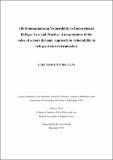(Re)Conceptualising vulnerability in international refugee law and practice: An exploration of the value of a more dynamic approach to vulnerability in refugee status determination

View/
Date
2020-05-07Author
Hamilton, Luke
Metadata
Show full item recordUsage
This item's downloads: 650 (view details)
Abstract
This thesis investigates whether a reconceptualisation of the concept of vulnerability is required in order to ensure that the needs of ‘vulnerable’ asylum seekers are accommodated in national refugee status determination (RSD) procedures. The inquiry is prompted by increasing allusion to vulnerability in refugee law and policy that is taking place despite a lack of scholarly or judicial material to guide approaches to vulnerability assessment in national asylum systems.
Through systematic analysis of international, European and Irish refugee law and policy, this thesis demonstrates that whilst the development of a coherent normative approach to vulnerability is in its embryonic stages at the international level, progress is ad hoc and stymied by inconsistent practice. This has implications on the ground at the national level, where asylum practitioners rely upon overly simplistic, group-based formulations of vulnerability that entrench stigma and stereotypes in the absence of clear conceptual guidance. The consequence of this overarching conceptual fuzziness is that asylum seekers’ individual needs are not systematically recognised or addressed, reducing their capacity to fully articulate their protection claim, which can result in an erroneous RSD decision.
On the basis of findings from doctrinal analysis and empirical interviews with asylum practitioners, the thesis ultimately argues that a reconceptualisation of vulnerability is indeed required. It is proposed that vulnerability could more usefully be understood as ‘dynamic.’ The dynamic concept is more nuanced, recognising that vulnerability is fluid, stemming from a range of sources and fluctuating in intensity concurrent with the refugee journey. Input from practitioners allows the analysis to move beyond the theoretical and to tease out how a more nuanced approach to vulnerability could be operationalised in practice, lending a perspective to the debate on vulnerability that has heretofore been missing. The thesis concludes by using the findings to articulate how vulnerability assessment should be implemented in the national asylum system to greater protective effect under the dynamic conceptual approach, flagging some challenges that will first need to be overcome and the steps future research and advocacy might take.
Collections
Except where otherwise noted, this item's license is described as Attribution-NonCommercial-NoDerivs 3.0 Ireland
Related items
Showing items related by title, author, creator and subject.
-
The Relationship between Refugee Exclusion Law and International Law: Convergence or Divergence?
Rikhof, Joseph (2011-05-30)While asylum as a concept has been known since ancient times, persons with a criminal background have always been treated with suspicion and depending on the time and place would either be granted asylum in a limited form ... -
Golden cages: refugees, camps and the politics of law
Bushnell, Alexis (2015-12-09)This thesis explores the interplay between the refugee as a figure and the refugee camp as a space, and interrogates how this interplay has informed international refugee law as well as examining the gaps in international ... -
‘Can the feminist movement provide legal services to refugees?’ Feminist lawyering, women refugees and gender based violence in urban Uganda
Noir, Maëlle (NUI Galway, 2024-04-03)‘Can the feminist movement provide legal services to refugees?’ This is the question that this thesis seeks to answer through an assessment of the applicability of feminist lawyering to address gender-based violence ...

